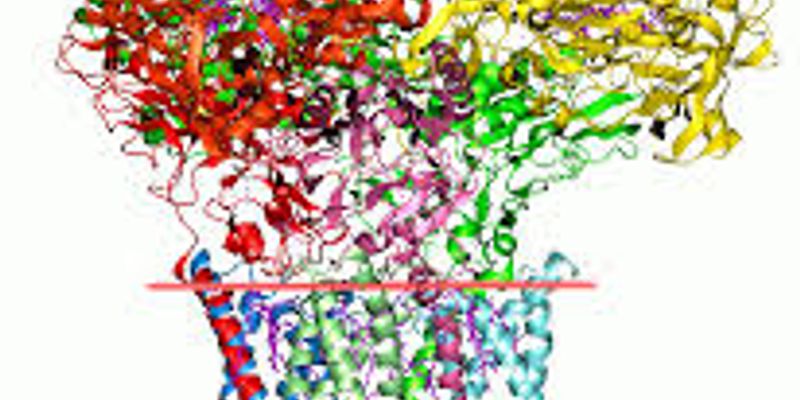Structural Bioinformatics
Structural Bioinformatics: is the branch of bioinformatics that is related to the analysis and prediction of the three-dimensional structure of biological macromolecules such as proteins, RNA, and DNA.
-
SEP 13, 2018 | 10:30 AMHorizontal gene transfer (HGT) – or the non-genealogical transmission of DNA between organisms – is the dominant mode responsible for the spread of antibiotic resistance genes. Co...SEP 13, 2018 | 10:30 AMThe bacterium Pantoea stewartii subsp. stewartii causes Stewart’s wilt disease in corn and serves as a model for other xylem-dwelling phytopathogens. P. stewartii is transmitted to plan...SEP 13, 2018 | 9:00 AMThis two-part webinar will focus on novel techniques for obtaining unbiased results in 16S rRNA gene sequencing of challenging microbiome samples. Part 1 will feature QIAGEN’s solutions...Speaker: Matthew Fosbrink, PhD , Dominic O'NeilSEP 13, 2018 | 9:00 AMViruses outnumber bacteria in soil by as much as 1000:1. However, there are few studies which examine the ways viral communities impact the soil microbiome, chemical cycles, and plants. Recen...SEP 13, 2018 | 7:30 AMIn the US, the National Antimicrobial Resistance Monitoring System has been using WGS of Salmonella as a tool of routine surveillance since 2013. To date, NARMS has generated MIC and WGS data...Speaker: Patrick McDermott, MS, PhDPresented at: Microbiology & Immunology Virtual Event Series 2018
SEP 13, 2018 | 6:00 AMThe Alkek Center for Metagenomics and Microbiome Research (CMMR) at Baylor College of Medicine is pursuing numerous research and development efforts in the study of how the microbiome impacts...SEP 13, 2018 | 6:00 AMIn the US, the National Antimicrobial Resistance Monitoring System has been using WGS of Salmonella as a tool of routine surveillance since 2013. To date, NARMS has generated MIC and WGS data...SEP 12, 2018 | 1:30 PMDiseaseLand is an integrated genomics database and visualization software that helps researchers explore 1000s of public and private datasets covering, but not limited to therapeutic areas su...Speaker: Lucy Williams, PhDSEP 12, 2018 | 1:30 PMReducing the impact of infectious diseases is becoming increasingly vital as the prevalence of antimicrobial resistance (AMR) continues to rise, threatening the effective prevention and treat...SEP 12, 2018 | 12:00 PMEvery year, approximately 800,000 critically ill patients are hospitals in the USA with undiagnosed infections. The only option is to treat these patients with broad-spectrum antimicrobial th...SEP 12, 2018 | 12:00 PMWhole genome sequencing of bacterial isolates via next-generation sequencing is becoming a standard approach for clinical microbiology and bio-surveillance labs seeking to conduct outbreak in...Speaker: Winnie Ridderberg, PhDSEP 12, 2018 | 10:30 AMThe ongoing research and scientific debate on pathophysiology, classification, nomenclature and diagnosis of antiphospholipid syndrome illustrates the complexity of cellular membranes, their...SEP 12, 2018 | 10:30 AMSome bacteria can use an electrode as an electron donor for respiration, generating an electrical current in the process. We are trying to understand a bacterial community that uses electrici...SEP 12, 2018 | 9:00 AMAntibiotic resistance is a national and global public health crisis. Each year in the United States (US), at least 2 million people become infected with antibiotic-resistant bacteria an...Speaker: Haley Appaneal, Pharm D.Presented at: Microbiology & Immunology Virtual Event Series 2018
SEP 12, 2018 | 9:00 AMWhooping cough caused by Bordetella infection has resurged in recent years. Dr. Karissa Culbreath will discuss the clinical presentation of Bordetella infection and its public health im...Speaker: Karissa Culbreath, Ph.D., D(ABMM)SEP 12, 2018 | 7:30 AMThere are new generations of comprehensive multiplex molecular panels available for infectious diseases syndromic diagnostics. They are able to rapidly detect and identify the most common pat...Speaker: Vera Tesic, MD, MS, D (ABMM), M (ASCP)Presented at: Microbiology & Immunology Virtual Event Series 2018
SEP 12, 2018 | 6:00 AMNext-generation DNA sequencing has opened new possibilities for microbial water quality monitoring, particularly for addressing emerging concerns like antibiotic resistance and opportunistic...SEP 12, 2018 | 6:00 AMThe WHO has set ambitious targets for eliminating TB in low-incidence countries such as the US and Canada. While it’s true that the majority of TB cases in these settings arise from rea...MAY 10, 2018 | 10:30 AMC.E. CREDITSStructural variants (SVs), defined as rearrangements of genomic sequences, are both a major source of genetic diversity in human populations and are also directly responsible for the pathogen...MAY 09, 2018 | 6:00 AMThe Genome in a Bottle Consortium (GIAB) has characterized an Ashkenazi trio from the Personal Genome Project (NIST Reference Material 8392) with 12 short, long, and linked read sequencing an...APR 24, 2018 | 8:00 AMDATE: April 24, 2018TIME: 8:00AM PSTIn this talk we will cover basic principles of KASP® genotyping chemistry and designing assays that are specific to desired targets. We will go o...OCT 12, 2017 | 12:00 PMAcral lentiginous melanoma (ALM) is a rare sun-shielded melanoma subtype associated with worse survival than cutaneous melanoma (CM), a more common form of skin cancer linked to exposure to u...Speaker: Winnie Liang, PhDSEP 14, 2017 | 1:30 PMPlant viruses cause significant damage in terms of reduction in quality and quantity of yield in a wide range of crop plants worldwide. The majority of plant viruses are transmitted from one...SEP 14, 2017 | 12:00 PMGenome sequencing can be used to discover new pathogens but it can also be used to monitor known ones. This is known as genomic surveillance and it becoming an increasingly important tool in...Speaker: Josh QuickPresented at: Microbiology & Immunology Virtual Event Series 2017
Sponsored By: Oxford Nanopore Technologies
SEP 13, 2018 | 10:30 AM
Horizontal gene transfer (HGT) – or the non-genealogical transmission of DNA between organisms – is the dominant mode responsible for the spread of antibiotic resistance genes. Co...
SEP 13, 2018 | 10:30 AM
The bacterium Pantoea stewartii subsp. stewartii causes Stewart’s wilt disease in corn and serves as a model for other xylem-dwelling phytopathogens. P. stewartii is transmitted to plan...
SEP 13, 2018 | 9:00 AM
This two-part webinar will focus on novel techniques for obtaining unbiased results in 16S rRNA gene sequencing of challenging microbiome samples. Part 1 will feature QIAGEN’s solutions...
Speaker:
Matthew Fosbrink, PhD
, Dominic O'Neil
SEP 13, 2018 | 9:00 AM
Viruses outnumber bacteria in soil by as much as 1000:1. However, there are few studies which examine the ways viral communities impact the soil microbiome, chemical cycles, and plants. Recen...
SEP 13, 2018 | 7:30 AM
In the US, the National Antimicrobial Resistance Monitoring System has been using WGS of Salmonella as a tool of routine surveillance since 2013. To date, NARMS has generated MIC and WGS data...
Speaker:
Patrick McDermott, MS, PhD
Presented at: Microbiology & Immunology Virtual Event Series 2018
SEP 13, 2018 | 6:00 AM
The Alkek Center for Metagenomics and Microbiome Research (CMMR) at Baylor College of Medicine is pursuing numerous research and development efforts in the study of how the microbiome impacts...
SEP 13, 2018 | 6:00 AM
In the US, the National Antimicrobial Resistance Monitoring System has been using WGS of Salmonella as a tool of routine surveillance since 2013. To date, NARMS has generated MIC and WGS data...
SEP 12, 2018 | 1:30 PM
DiseaseLand is an integrated genomics database and visualization software that helps researchers explore 1000s of public and private datasets covering, but not limited to therapeutic areas su...
Speaker:
Lucy Williams, PhD
SEP 12, 2018 | 1:30 PM
Reducing the impact of infectious diseases is becoming increasingly vital as the prevalence of antimicrobial resistance (AMR) continues to rise, threatening the effective prevention and treat...
SEP 12, 2018 | 12:00 PM
Every year, approximately 800,000 critically ill patients are hospitals in the USA with undiagnosed infections. The only option is to treat these patients with broad-spectrum antimicrobial th...
SEP 12, 2018 | 12:00 PM
Whole genome sequencing of bacterial isolates via next-generation sequencing is becoming a standard approach for clinical microbiology and bio-surveillance labs seeking to conduct outbreak in...
Speaker:
Winnie Ridderberg, PhD
SEP 12, 2018 | 10:30 AM
The ongoing research and scientific debate on pathophysiology, classification, nomenclature and diagnosis of antiphospholipid syndrome illustrates the complexity of cellular membranes, their...
SEP 12, 2018 | 10:30 AM
Some bacteria can use an electrode as an electron donor for respiration, generating an electrical current in the process. We are trying to understand a bacterial community that uses electrici...
SEP 12, 2018 | 9:00 AM
Antibiotic resistance is a national and global public health crisis. Each year in the United States (US), at least 2 million people become infected with antibiotic-resistant bacteria an...
Speaker:
Haley Appaneal, Pharm D.
Presented at: Microbiology & Immunology Virtual Event Series 2018
SEP 12, 2018 | 9:00 AM
Whooping cough caused by Bordetella infection has resurged in recent years. Dr. Karissa Culbreath will discuss the clinical presentation of Bordetella infection and its public health im...
Speaker:
Karissa Culbreath, Ph.D., D(ABMM)
SEP 12, 2018 | 7:30 AM
There are new generations of comprehensive multiplex molecular panels available for infectious diseases syndromic diagnostics. They are able to rapidly detect and identify the most common pat...
Speaker:
Vera Tesic, MD, MS, D (ABMM), M (ASCP)
Presented at: Microbiology & Immunology Virtual Event Series 2018
SEP 12, 2018 | 6:00 AM
Next-generation DNA sequencing has opened new possibilities for microbial water quality monitoring, particularly for addressing emerging concerns like antibiotic resistance and opportunistic...
SEP 12, 2018 | 6:00 AM
The WHO has set ambitious targets for eliminating TB in low-incidence countries such as the US and Canada. While it’s true that the majority of TB cases in these settings arise from rea...
MAY 10, 2018 | 10:30 AM
C.E. CREDITS
Structural variants (SVs), defined as rearrangements of genomic sequences, are both a major source of genetic diversity in human populations and are also directly responsible for the pathogen...
MAY 09, 2018 | 6:00 AM
The Genome in a Bottle Consortium (GIAB) has characterized an Ashkenazi trio from the Personal Genome Project (NIST Reference Material 8392) with 12 short, long, and linked read sequencing an...
APR 24, 2018 | 8:00 AM
DATE: April 24, 2018TIME: 8:00AM PSTIn this talk we will cover basic principles of KASP® genotyping chemistry and designing assays that are specific to desired targets. We will go o...
OCT 12, 2017 | 12:00 PM
Acral lentiginous melanoma (ALM) is a rare sun-shielded melanoma subtype associated with worse survival than cutaneous melanoma (CM), a more common form of skin cancer linked to exposure to u...
Speaker:
Winnie Liang, PhD
SEP 14, 2017 | 1:30 PM
Plant viruses cause significant damage in terms of reduction in quality and quantity of yield in a wide range of crop plants worldwide. The majority of plant viruses are transmitted from one...
SEP 14, 2017 | 12:00 PM
Genome sequencing can be used to discover new pathogens but it can also be used to monitor known ones. This is known as genomic surveillance and it becoming an increasingly important tool in...
Speaker:
Josh Quick
Presented at: Microbiology & Immunology Virtual Event Series 2017
Sponsored By: Oxford Nanopore Technologies
Sponsored By: Oxford Nanopore Technologies
























